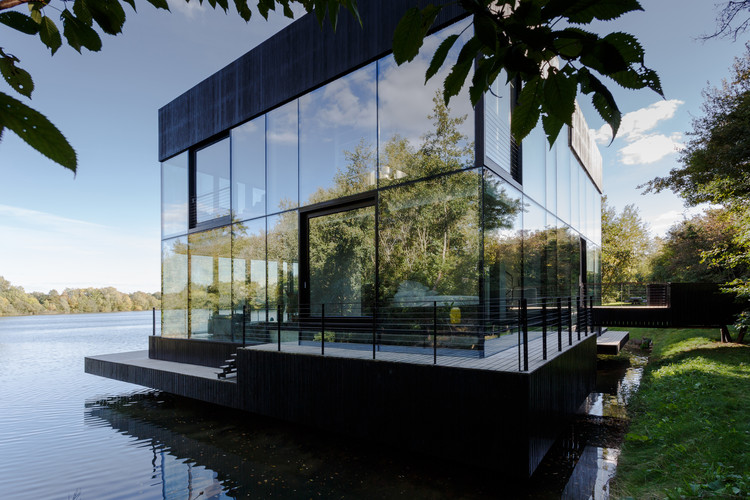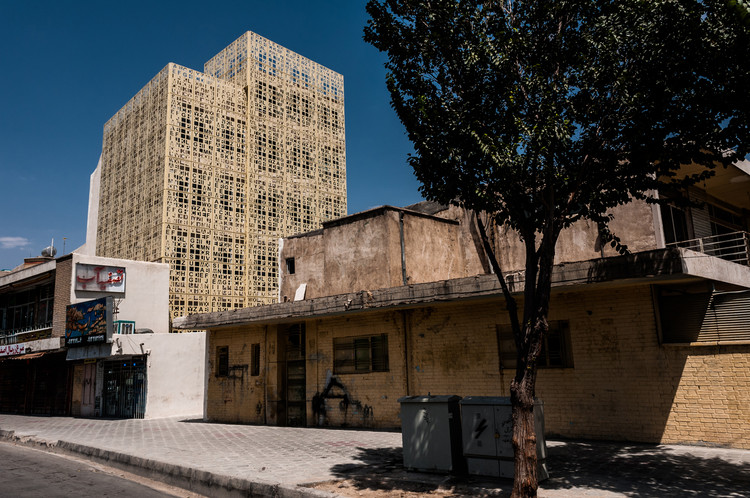House in the Mountains Wolff Architects
2014-09-28 01:00
架构师提供的文本描述。这座房子的遗址位于南非塞德伯格山脉深处的一个农场上,那里的景观与开普敦植物区的生物多样性紧密相连。房子的设置是由三个因素决定的,第一,在植被中选择一个“秃顶”点(与植物学家协商),以尽量减少房子对植物区系的影响。
Text description provided by the architects. The site for this house is on a farm deep in the Cederberg mountains in South Africa, a landscape dense with biodiversity of the Cape Floristic Region. The setting for the house was determined by three factors, firstly a ‘bald’ spot in the vegetation was selected (in consultation with botanists) to minimise the impact of the house on the flora.
Courtesy of Heinrich Wolff
海因里希·沃尔夫


其次,由于顾客更喜欢住在户外,所以在自然景观中发现了“房间”,可以容纳户外烹饪和饮食、生活和睡眠。房屋的建造部分便于居住在房屋的未建部分。
Secondly, since the clients prefer to live outdoors as far as possible, “rooms” were found in the natural landscape which could accommodate outdoor cooking and eating, living and sleeping. The built part of the house facilitates living in the unbuilt part of the house.
Courtesy of Heinrich Wolff
海因里希·沃尔夫


第三,环境是由它的能力决定的,它能从特定的地点组成一个视图;建筑师认为远景不够丰富,应该在前景和中间地带辅以清晰的景观特征。例如,选定的地点在北面的主要景观前面有岩石山脊,这就为房子的空间创造了一个明确的边缘,而不需要任何建造的手段来达到这样的边界。
Thirdly, the setting was determined by its ability to compose a view from that specific location; the architects believe that a distant view is not rich enough a view and should be supplemented by articulate landscape features in the foreground and the middleground. For instance, the selected site has rocky ridges right in front of the primary view to the north that creates a defined edge to the space of the house without needing any built means to achieve such a boundary.
Courtesy of Heinrich Wolff
海因里希·沃尔夫


房子应该是防火和防狒狒,但最大的挑战是看到现场回到我们的办公室,250公里之外。现场没有人类生命的痕迹(篱笆、电线杆、建筑物等)很难判断景观特征的规模。更糟糕的是,传统的土地测量只会绘制等高线图来描述地形,而无法描述过多的岩石和灌木丛。
The house should be fireproof and baboonproof, but the greatest challenge of the project is to see the site back in our office, 250km away. With no marks of human life on site, (fences, electricity poles, building, etc.) it became very difficult to judge the scale of landscape features. To make matters worse, conventional land surveying produces contour plans that describe the topography only with no ability to describe the plethora of rocks and bush.
Courtesy of Heinrich Wolff
海因里希·沃尔夫


为了设计这座建筑,我们必须开发一种同时观察植被、岩石和地形的方法。解决方案是用3D扫描仪扫描景观,产生点云。我们没有按照传统的方法使用这些扫描来产生固体表面,我们开发了使用原始状态的点云的方法,使整个自然界的规模和特征在我们设计的过程中呈现出来。剖面图和高程图上所示的景观是确切的地点。
To design the building we had to develop a way to see the vegetation, rocks and topography simultaneously. The solution was to have the landscape scanned with a 3D scanner, producing a Point Cloud. Instead of following the conventional route of using these scans to produce solid surfaces, we developed ways of using the Point Cloud in its raw state to have the scale and character of the entire natural world present, while we design. The landscape indicated on the section and elevation drawings is the exact site.
Courtesy of Heinrich Wolff
海因里希·沃尔夫


气候与环境
Climate and environment
该农场位于南非冬季降雨地区,冬季寒冷,夏季炎热。西风吹过山谷,有时会很刺耳。为了保护房子不受这股风的影响,这座房子坐落在西方一座岩石峭壁旁。房子的西边是用来遮风的。
The farm is within the winter rainfall area of South Africa, with cold winters and very hot summers. A constant Westerly wind comes down the valley and can sometimes be quite harsh. To protect the house against this wind the house was sited next to a rocky cliff to the West. The Western edge of the house was designed to screen the wind from the balcony.
Courtesy of Heinrich Wolff
海因里希·沃尔夫


北侧的一个巨大的悬垂为夏季的阳光提供了保护。北方的双层砖墙也有同样的作用。所有房间的窗户内部都有百叶窗以隔离开口。客厅和餐厅使用低E玻璃。
A large overhang on the Northern side provides protection from the summer sun. The double brick walls to the North do the same job. All the rooms have shutters on the inside of the windows to insulate the openings. Low E glass was used in the living and dining room.
© James Puttick
c.詹姆斯·普蒂克


这所房子与任何外部服务都没有连接;电力由太阳能发电,水是从钻孔提供的,污水是在现场设置的,以保护植被不受富含养分的污水排放。
The house has no connection to any outside services; electricity is generated by solar power, water is supplied from a borehole and sewerage is contained on site to protect the vegetation from nutrient rich effluent.
Ground Floor Plan


为了将房子的视觉影响降到最低,该项目被分成三个独立的街区,包括卧室、浴室和厨房。客厅和餐厅被设想为街区之间的一个封闭的“庭院”。建筑物的碎裂现象模拟了周围破碎的岩石峭壁。
To minimise the visual impact of the house, the program was split into three separate blocks, containing bedrooms, bathrooms and the kitchen. The living and dining room is conceived of as an enclosed ‘courtyard’ between the blocks. The fragmentation of the building mass mimics the broken up rock cliffs around it.
© James Puttick
c.詹姆斯·普蒂克


为了进一步减少视觉上的影响,房屋将采用与周围岩石颜色相同的材料建造;所有砖块的外墙都是用70%再生混凝土制成的清水水泥砖。为了保护房子不受丛林大火的影响,砖墙是必要的。
To further minimise the visual impact, the house will be built of a material which is identical in colour to the rocks around it; all exterior walls of the blocks are built of fairface cement brick, made with 70% recycled concrete. The brick exterior is necessary to protect the house from bush fires.
Courtesy of Heinrich Wolff
海因里希·沃尔夫


房间的内饰是粉刷的,漆成白色。所有的地板都是用没有混凝土表层的抛光铺砌砖制成的。天花板是由南非松木梁和地板制成的,这给室内提供了占主导地位的黄色颜色。
The interiors of rooms are plastered and painted white. All floors are made with polished paving brick with no concrete surface beds. The ceilings are made with South African Pine beams and floorboards, which gives a dominant yellow colour to the interior.
© James Puttick
c.詹姆斯·普蒂克


形式策略
Formal strategy
在一个没有人类干预迹象的地区,很难判断任何事情的规模。因此,无标度被用作建筑的主要特征;所有传统的外部建筑元素(屋顶、下水管、窗户等)是为了剥夺观察者判断天平的任何东西。这是通过在各块砖的短边上造一堵双面墙来实现的,这样就可以单独在巨大的砖块中将开口切割到外部。外壳上的所有开口都被夸大了,以从远处缩小建筑的明显规模。
In a landscape where there are no marks of human intervention, it is hard to judge the scale of anything. Scalelessness was therefore used as a primary characteristic of the architecture; all conventional external building elements (roofs, downpipes, windows, etc.) were concealed to deprive the observer of anything to judge the scale by. This was achieved by making a double wall on each of the short sides of the blocks which allows openings to be cut into the exterior in the massive brick alone. All openings in the exterior envelope were exaggerated in size to diminish the apparent scale of the building from a distance.




















































Architects Wolff Architects
Location West Coast DC, South Africa
Category Houses
Architect in Charge Heinrich Wolff
Project Year 2013
Photographs James Puttick
























